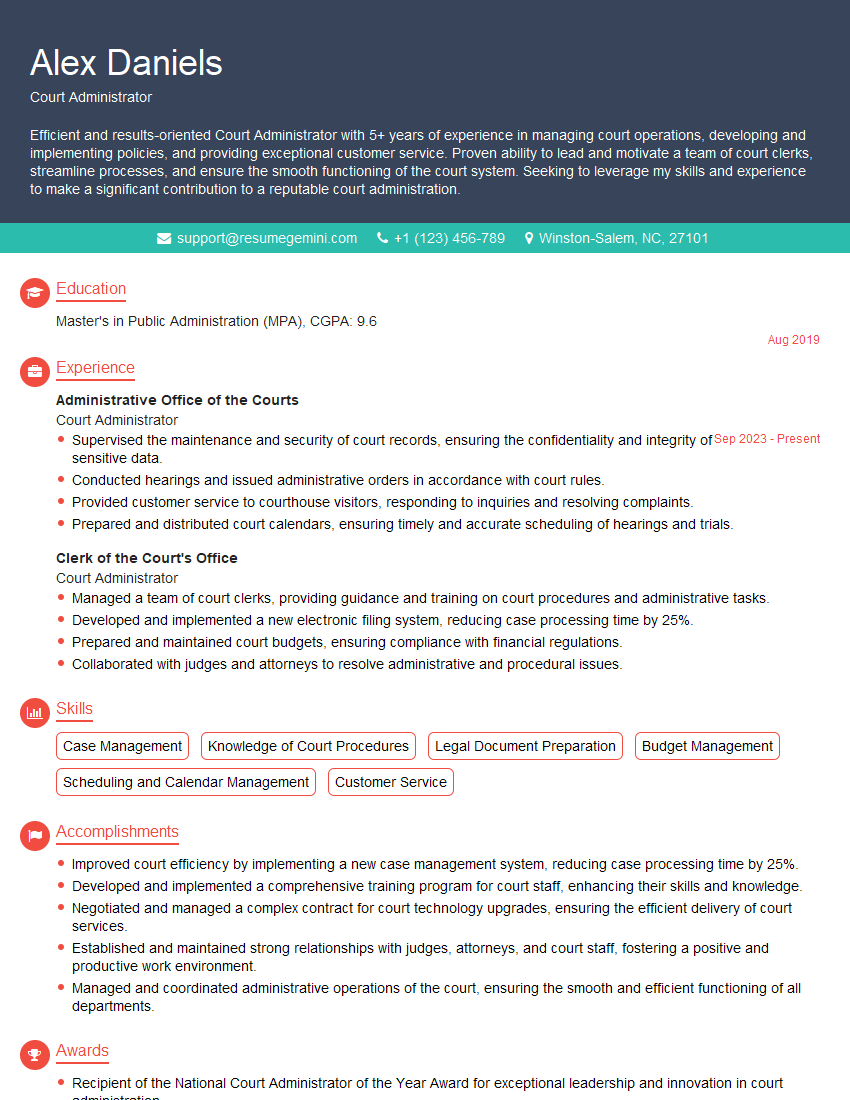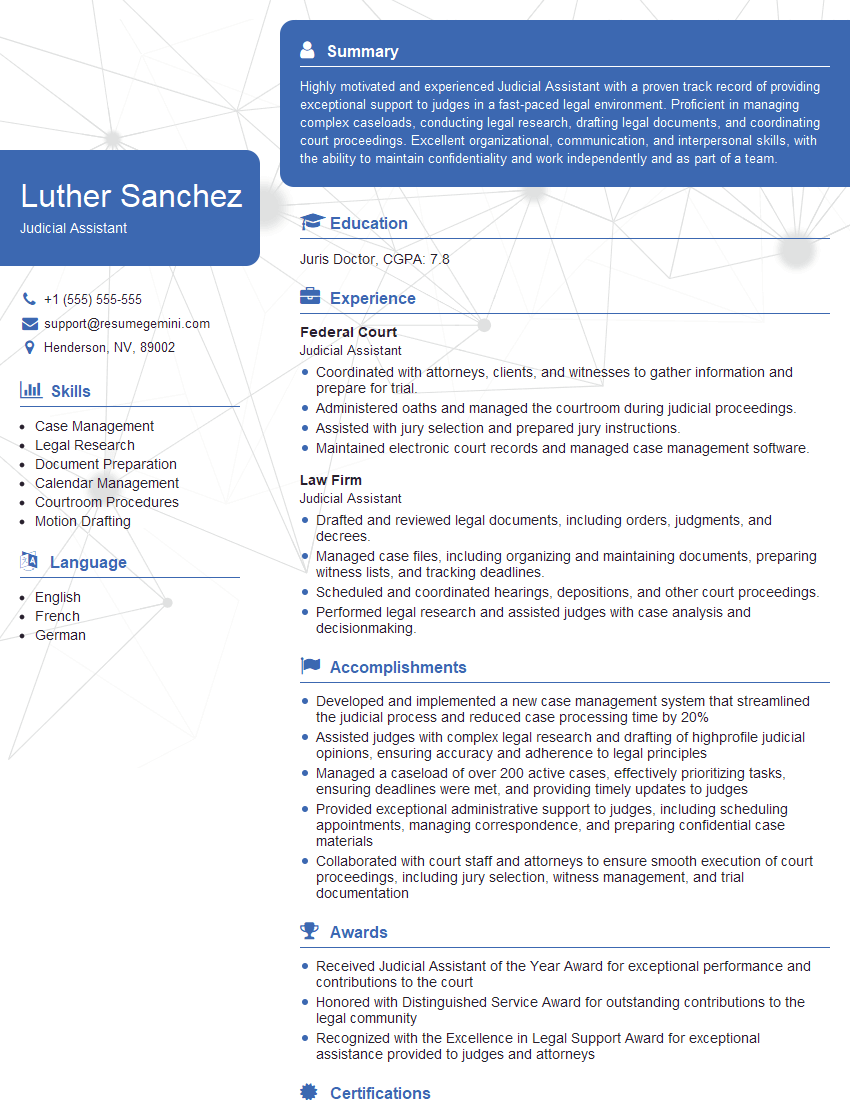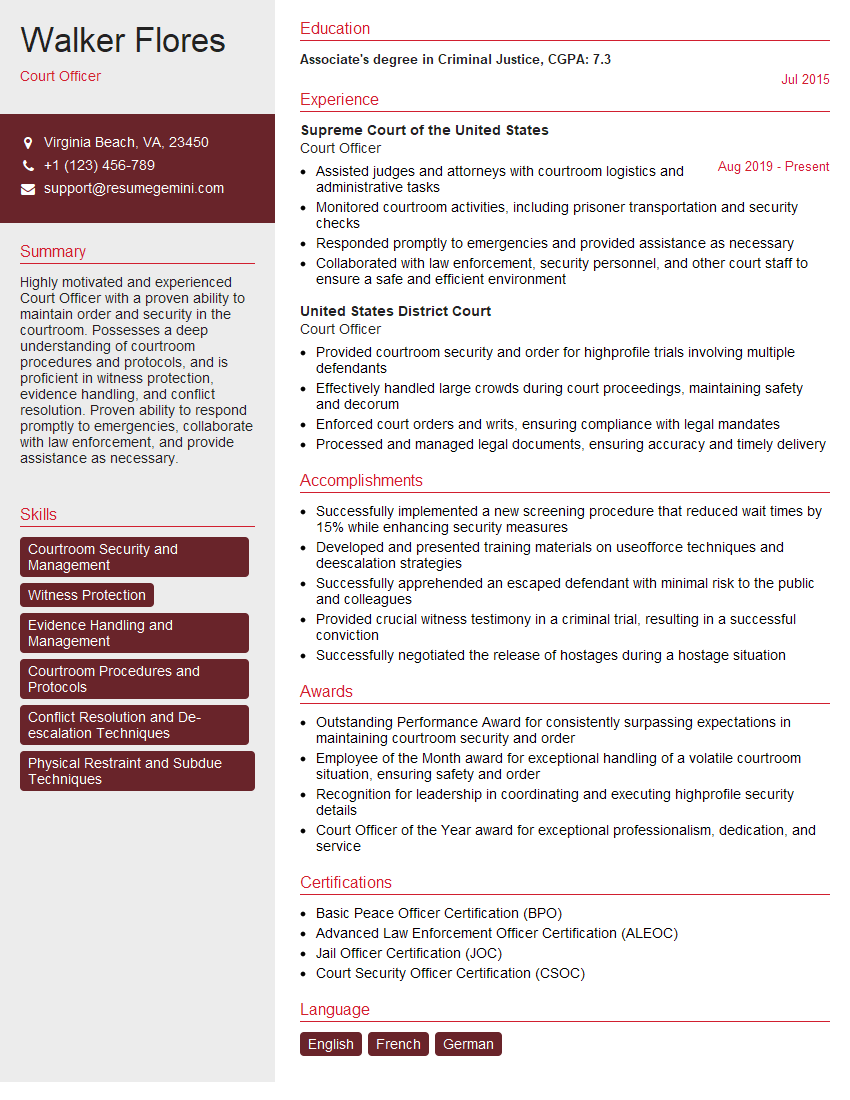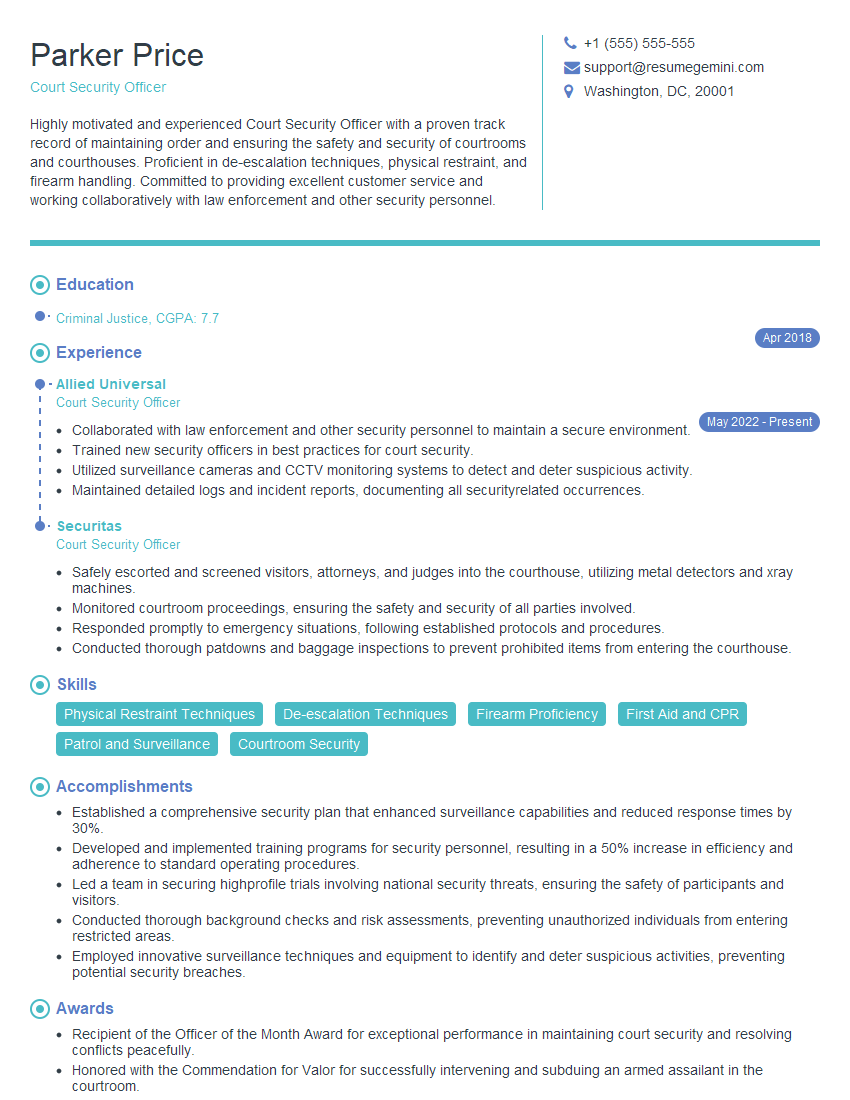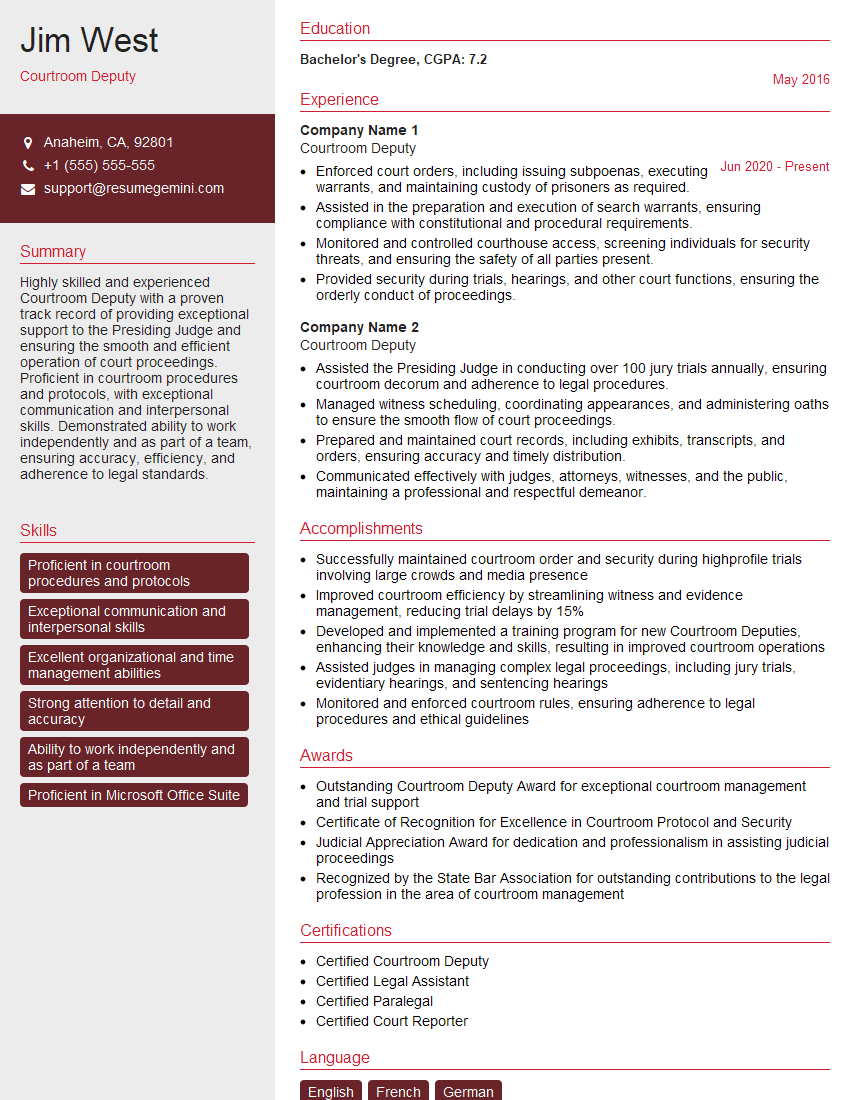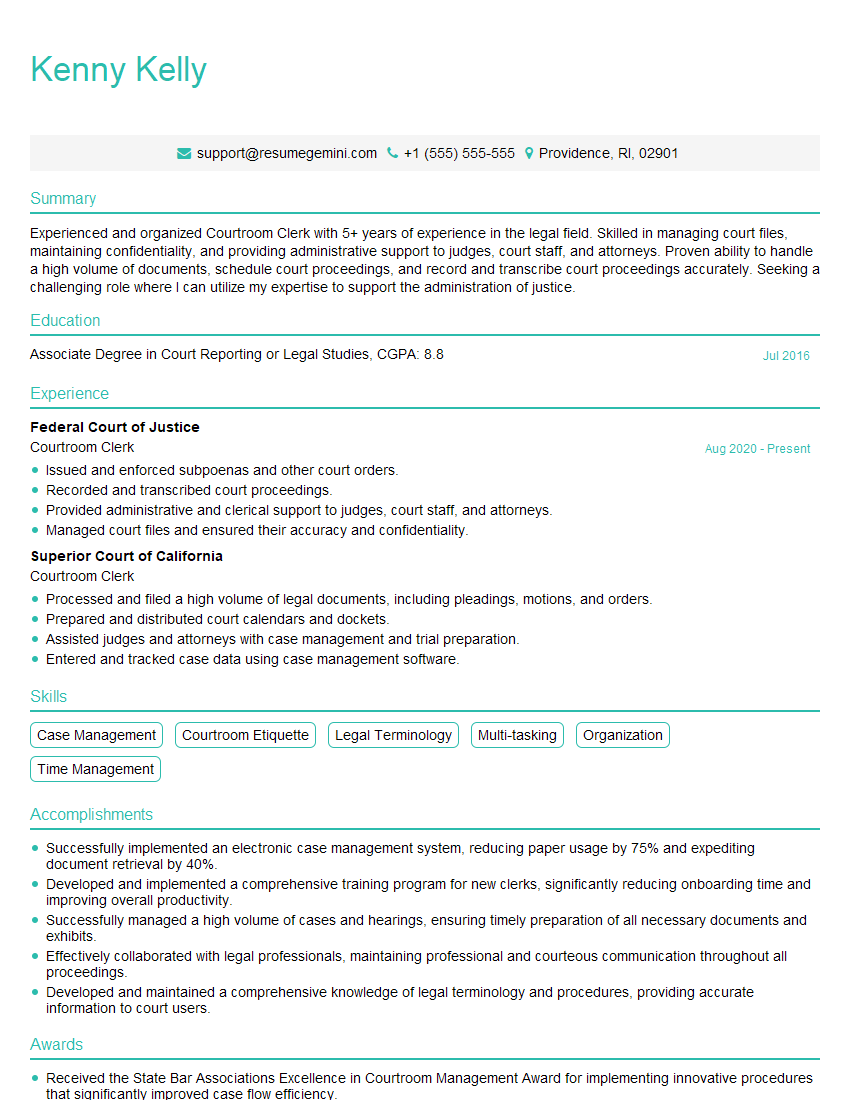Are you ready to stand out in your next interview? Understanding and preparing for Maintaining Courtroom Order interview questions is a game-changer. In this blog, we’ve compiled key questions and expert advice to help you showcase your skills with confidence and precision. Let’s get started on your journey to acing the interview.
Questions Asked in Maintaining Courtroom Order Interview
Q 1. Describe your experience in maintaining order in a courtroom setting.
Maintaining courtroom order is a multifaceted skill requiring a blend of firmness, diplomacy, and a deep understanding of legal procedures. My experience spans over [Number] years, encompassing various court settings – from bustling county courts to more formal superior courts. I’ve handled everything from minor disruptions to significant security breaches. My approach always prioritizes de-escalation and the preservation of the court’s integrity, while ensuring the safety of all involved. I’ve successfully managed situations involving unruly spectators, emotional witnesses, and even attempts to interfere with proceedings. My experience has solidified my understanding of the delicate balance between maintaining order and upholding the rights of all participants.
For example, in one instance, a spectator repeatedly interrupted proceedings with loud outbursts. Through calm, assertive communication and a clear warning about contempt of court, I was able to resolve the situation without further incident. In another instance, I had to coordinate with security personnel to remove a disruptive individual who was physically threatening towards a witness. The key is to remain impartial, yet decisively act to protect the court’s dignity and the well-being of everyone present.
Q 2. What procedures would you follow if a disruptive individual entered the courtroom?
If a disruptive individual entered the courtroom, my procedure would follow a well-defined protocol starting with observation and assessment. Firstly, I’d observe their behavior to determine the level of threat. If it’s a minor disruption, a verbal warning, delivered calmly yet firmly, might suffice. However, if the individual is behaving aggressively or threateningly, I’d immediately alert security personnel. Simultaneously, I’d attempt to de-escalate the situation using verbal communication techniques – speaking calmly, actively listening, and attempting to understand their reasons for disruption. Depending on the situation, I might seek guidance from the judge regarding next steps. Removal from the courtroom, potentially with the involvement of law enforcement, would be the next step if other methods failed to restore order. Clear, documented records of the entire incident would be maintained as part of the court record.
Consider a scenario where an individual bursts in shouting. I’d immediately notify security, while approaching the person calmly and asking them to lower their voice and explain their reason for being there. If cooperation isn’t forthcoming, security would intervene to escort them out, documenting every step.
Q 3. How do you ensure the safety and security of courtroom personnel and the judge?
Ensuring the safety and security of courtroom personnel and the judge is paramount. This involves multiple layers of security measures, starting with physical security checks at entry points. Metal detectors, bag checks, and security personnel are crucial deterrents. Furthermore, maintaining a clear line of sight around the judge’s bench is essential. Regular security assessments, including vulnerability checks and emergency procedures, are crucial. Open communication between security personnel, court staff, and law enforcement is vital to promptly addressing any potential threats. A well-defined emergency response plan should be in place and regularly practiced, including evacuation procedures and communication protocols. I would also ensure all personnel are trained in basic security protocols and aware of emergency procedures.
For instance, we conduct regular training exercises to prepare for different scenarios, including bomb threats or active shooter situations. This involves coordinated efforts between courtroom staff, security, and local law enforcement.
Q 4. Explain your understanding of courtroom decorum and etiquette.
Courtroom decorum and etiquette are vital for maintaining order and respect for the judicial process. It involves appropriate dress, respectful behavior, and adherence to the judge’s instructions. This includes turning off electronic devices, refraining from talking during proceedings, standing when the judge enters or leaves, and addressing the judge formally. Witnesses are expected to answer questions truthfully and respectfully. Jurors are expected to remain impartial and attentive. A lack of decorum can disrupt proceedings and undermine the court’s authority. Education and clear communication are essential to ensuring participants understand and follow proper courtroom etiquette. Visual aids, such as signs reminding people to silence their phones and maintain decorum, can also be effective.
Think of it like attending a formal dinner – proper attire, polite conversation, and respecting the host (the judge) are all expected. The same level of respect and decorum is expected in a courtroom setting.
Q 5. What methods do you use to de-escalate tense situations in a courtroom?
De-escalation techniques are crucial in managing tense situations. My approach focuses on calm, assertive communication, active listening, and empathy. I begin by attempting to understand the source of the tension, addressing concerns directly and validating feelings where appropriate. Providing clear and concise instructions, while maintaining a calm demeanor, helps maintain control. Offering breaks or alternatives can sometimes diffuse tension. If verbal de-escalation fails, I may enlist the help of court personnel or security, always prioritizing a safe and respectful resolution. A crucial aspect is remaining impartial and avoiding escalation through aggressive or confrontational responses.
For example, if two attorneys are engaging in a heated argument, I might intervene by reminding them of the court’s rules and requesting they address their disagreement respectfully or take a brief recess to regroup. The key is to calmly restore order without taking sides.
Q 6. How would you handle a witness who becomes emotionally distraught?
Handling an emotionally distraught witness requires sensitivity and understanding. The first priority is to ensure their safety and well-being. I would offer them a moment to compose themselves, perhaps providing water or allowing them a brief break outside the courtroom. Depending on the situation, I might consult with the judge and attorneys about the best course of action. It’s essential to approach the witness with empathy and reassurance, avoiding pressure or judgment. Providing a calm and supportive environment can help them regain composure and continue their testimony. In cases of severe distress, I might coordinate with a court counselor or medical personnel.
Imagine a witness breaking down during testimony. My response would be to approach them calmly, offer support, and perhaps suggest a short break to gather themselves. The goal is to provide a safe and comforting environment while respecting the legal process.
Q 7. Describe your experience with managing evidence in a courtroom setting.
Managing evidence in a courtroom setting is a critical responsibility. This involves ensuring the chain of custody is maintained, meaning that there’s a clear, unbroken record of who had possession of the evidence at any given time. This is vital for its admissibility in court. I work closely with court personnel to receive, store, and handle evidence securely, following strict protocols to prevent tampering or contamination. Detailed logs are maintained for every piece of evidence, documenting its handling and location. This includes the date, time, and personnel involved at each stage of the process. During court proceedings, I’m responsible for presenting evidence as instructed by the judge and attorneys, ensuring its integrity is upheld throughout the process.
For instance, each piece of evidence is labeled, bagged, and sealed, with a detailed log maintained throughout its journey from collection to presentation in court, ensuring its authenticity and preventing any disputes about its handling.
Q 8. How do you ensure the proper flow of traffic and access in and out of the courtroom?
Maintaining proper courtroom traffic flow is crucial for efficiency and security. It involves a multi-faceted approach. First, clear signage is essential, directing visitors to designated entrances, waiting areas, and exits. This signage should be large, clear, and in multiple languages if necessary. Second, we employ trained personnel to guide individuals, particularly during peak times or high-profile cases. These individuals could be bailiffs, security officers, or court clerks. They assist with crowd management, directing people to appropriate areas, and ensuring smooth transitions between different courtroom phases (e.g., jury selection, witness testimony, recess).
Third, we implement a system to manage access. This could involve pre-screening of individuals using metal detectors or security checkpoints, along with controlling entry based on scheduled hearings or court orders. For example, we might separate public access from attorney and witness access using designated entry points and waiting areas. Finally, we regularly review and refine our traffic management strategy based on observed patterns and any feedback received, constantly striving for optimization.
Q 9. How familiar are you with courtroom security protocols and emergency procedures?
I am intimately familiar with courtroom security protocols and emergency procedures. My training encompasses active shooter response, bomb threats, and various other potential crises. I understand the specific security requirements for different types of cases, including high-profile trials or those involving sensitive information. These protocols typically involve working closely with local law enforcement and courthouse security to ensure a layered approach to protection.
This includes regular drills and training for all personnel involved in courtroom security, such as security officers, bailiffs, and even court staff. These drills simulate various scenarios to test response times and procedures, which is crucial for effective crisis management. We adhere strictly to established security protocols, consistently updating and revising them based on best practices and any changes to security threats.
Q 10. What are some common challenges faced in maintaining courtroom order, and how have you addressed them?
Maintaining courtroom order presents several challenges. One common issue is disruptive spectators, whether it’s talking during proceedings, using cell phones, or exhibiting inappropriate behavior. We address this by clearly communicating the rules of conduct before the proceedings start, employing visible security presence, and swiftly addressing any violations with warnings, or if necessary, removal from the courtroom. Another challenge is managing emotional outbursts from witnesses, defendants, or even members of the public. In such situations, patience and a calm demeanor are essential. We often employ de-escalation techniques, but if necessary, a recess or removal may be required to restore order.
Technological disruptions, such as equipment malfunctions, can also disrupt proceedings. This is handled through proactive maintenance and having backup systems in place. Finally, handling large numbers of people or managing access during high-profile cases necessitates careful planning and coordination with other court personnel and security agencies. Addressing these challenges often requires a blend of proactive prevention through communication and preparedness, and reactive measures for effective incident management.
Q 11. How would you handle a situation where a juror needs assistance?
If a juror needs assistance, my first step is to discreetly ascertain the nature of their request. This could involve approaching them directly or having a court officer do so to maintain decorum. If it’s a medical issue, immediate assistance is provided by contacting the appropriate emergency personnel or medical services. This could include paramedics or first aid provided by trained personnel within the courthouse.
If the issue isn’t urgent, like a request for clarification about court procedure or a personal need (such as using the restroom), I would coordinate with the judge to determine the best course of action, balancing the juror’s needs with the efficient continuation of the trial. For example, if a simple clarification is needed, the judge might address it directly to the entire jury; while a more private matter might necessitate a brief recess or a private conversation with the juror outside the courtroom.
Q 12. What measures do you take to prevent security breaches in the courtroom?
Preventing security breaches involves a layered approach. This begins with robust physical security measures like metal detectors, security checkpoints, and controlled access points. Surveillance cameras are strategically placed throughout the courtroom and surrounding areas. Bag checks are routinely performed. We also employ rigorous background checks and security training for all courtroom personnel.
Beyond the physical, we implement procedures for managing unauthorized items. This involves clear communication about prohibited items (weapons, electronic devices etc.), and consistent enforcement of those rules. Additionally, we cultivate a proactive security culture through regular security awareness training for all personnel, emphasizing vigilant observation and the importance of reporting any suspicious behavior. Regular security assessments are conducted to evaluate and improve our protocols.
Q 13. Explain your process for managing and responding to complaints or incidents in the courtroom.
My process for managing and responding to complaints or incidents begins with documenting the incident thoroughly. This includes a detailed description of the event, the time, the individuals involved, and any witnesses. I then attempt to address the issue swiftly and fairly, depending on its nature. Minor infractions might only require a verbal warning, while more serious matters could warrant a written report, or even the involvement of court officials or law enforcement.
All complaints are reviewed to identify patterns or areas for improvement in our security and procedural protocols. For instance, if we receive several complaints about difficulties with courtroom access, we might reassess the signage or staffing arrangements. Transparency and clear communication with those who file complaints are paramount, ensuring they understand the process and the actions taken.
Q 14. How would you handle a situation where a member of the public refuses to comply with courtroom rules?
Handling a situation where a member of the public refuses to comply with courtroom rules begins with a calm and respectful approach. A clear explanation of the rule and the reasons for its existence is the first step. We offer a chance for compliance. If the non-compliance persists despite explanation and a warning, we escalate the response depending on the severity of the disruption. This could involve a firm but polite request for them to leave, or the involvement of security personnel to escort them from the courtroom.
In extreme cases of disruptive behavior or threats to the proceedings, we might involve law enforcement to handle the situation. Throughout, we prioritize maintaining courtroom order and the safety and security of all involved. Proper documentation of the event, including witnesses and the actions taken, is crucial for maintaining a record and ensuring accountability. This documentation could prove useful in later legal proceedings or reviews of courtroom security protocols.
Q 15. Describe your experience interacting with judges, attorneys, jurors, and witnesses.
Maintaining courtroom order necessitates seamless interaction with all participants. My experience involves fostering respectful communication and ensuring adherence to procedural rules. With judges, I maintain a professional and discreet demeanor, anticipating their needs and proactively addressing potential disruptions. With attorneys, I facilitate smooth transitions between presentations, managing exhibits and ensuring everyone has access to necessary materials. Juror interactions focus on ensuring their comfort and security while strictly enforcing rules against outside communication or influence. Finally, witness interactions require sensitivity and understanding, particularly when dealing with vulnerable individuals, guiding them through procedures and ensuring their well-being.
For example, I once assisted a visibly nervous witness by calmly explaining the process and offering a glass of water, thereby ensuring they could provide their testimony effectively. Another time, I subtly de-escalated a tense exchange between opposing counsel by calmly reminding them of courtroom decorum.
Career Expert Tips:
- Ace those interviews! Prepare effectively by reviewing the Top 50 Most Common Interview Questions on ResumeGemini.
- Navigate your job search with confidence! Explore a wide range of Career Tips on ResumeGemini. Learn about common challenges and recommendations to overcome them.
- Craft the perfect resume! Master the Art of Resume Writing with ResumeGemini’s guide. Showcase your unique qualifications and achievements effectively.
- Don’t miss out on holiday savings! Build your dream resume with ResumeGemini’s ATS optimized templates.
Q 16. How do you ensure the confidentiality of sensitive information within the courtroom?
Confidentiality is paramount. We employ multiple layers of security. Sensitive documents are kept in secure storage, accessible only to authorized personnel. Discussions involving confidential information are held in private chambers or designated areas. All electronic devices, including computers and recording equipment, are secured with password protection and monitored for unauthorized access. Furthermore, strict protocols prevent unauthorized recording or photography within the courtroom. All personnel involved understand and are bound by strict confidentiality agreements, and any breaches are dealt with swiftly and according to legal procedures.
For instance, if a sensitive document is inadvertently left out, we have a documented procedure to retrieve it, log the incident, and ensure nobody else has accessed it. We regularly conduct security audits to ensure our processes remain effective.
Q 17. How would you respond to a threat or suspected threat in the courtroom?
Responding to threats requires immediate action and a calm, decisive approach. My first step is to assess the threat’s nature and credibility. This involves observing the individual’s behavior, listening to their words, and considering the context. If a direct threat is made, I immediately alert security personnel and law enforcement. If it’s a suspected threat, I discreetly monitor the individual, keeping the judge and court personnel informed. This also involves utilizing security cameras to record and monitor the individual’s behavior. Simultaneously, I’d work with the judge and bailiffs to clear the courtroom and implement appropriate evacuation procedures if needed.
In a past incident, a disruptive individual made veiled threats. I alerted security, who monitored the individual discretely until he was apprehended outside the courthouse without incident. The calm, measured response prevented escalation.
Q 18. What is your understanding of the legal framework governing courtroom security?
The legal framework governing courtroom security encompasses various laws and regulations at federal, state, and local levels. These aim to ensure the safety and security of judges, jurors, witnesses, attorneys, and the public. Key areas include maintaining order, protecting against threats of violence, preventing the unauthorized introduction of weapons, safeguarding evidence, and ensuring the confidentiality of proceedings. Specific regulations might address security protocols for specific types of cases (e.g., high-profile trials) or the use of specific security technologies.
Understanding these frameworks is crucial for ensuring compliance and implementing effective security measures, adapting strategies as needed for different legal contexts and security risks.
Q 19. How do you utilize technology to enhance courtroom security and efficiency?
Technology plays a significant role in enhancing both security and efficiency. Metal detectors and X-ray machines are standard, screening individuals entering the courtroom. Surveillance cameras provide visual monitoring of the courtroom and surrounding areas. Access control systems regulate entry, granting access only to authorized individuals. Furthermore, secure communication systems facilitate confidential discussions. Digital evidence management systems enhance efficiency and security by providing a controlled environment for storing and accessing digital evidence.
For instance, we utilize a secure cloud-based system for storing and sharing sensitive documents among authorized personnel, enhancing both efficiency and security. We regularly update our security systems with the latest technology and training programs to ensure that our protocols reflect best practices.
Q 20. How do you ensure the timely execution of court proceedings?
Timely execution is crucial for efficient justice. This involves careful scheduling, proactive management of resources, and effective communication. My role includes ensuring the courtroom is prepared in advance, all necessary documents and technology are readily available, and witnesses are summoned and briefed properly. I collaborate with court personnel to minimize delays and ensure smooth transitions between different stages of the proceedings. Effective time management techniques and proactive problem-solving are essential in addressing unexpected interruptions.
For example, I recently coordinated with the court clerk to ensure that exhibits were pre-organized, saving several minutes during trial proceedings. Promptly addressing minor technical glitches prevented larger delays.
Q 21. Describe your experience with using security equipment such as metal detectors or surveillance cameras.
My experience with security equipment is extensive. I’m proficient in operating and maintaining metal detectors, ensuring they are regularly calibrated and functioning correctly. I’m familiar with various surveillance camera systems, understanding their capabilities for monitoring and recording activities in and around the courtroom. I know how to use the footage for investigations and for producing evidence if necessary, but always within the bounds of privacy regulations. Furthermore, I am trained in the proper protocols for reacting to alarms or unusual events detected by the security systems.
For example, I’ve used surveillance footage to identify an individual who had left a suspicious package near the courthouse, allowing security to investigate and safely remove the package. Regular maintenance of metal detectors ensures consistent, reliable security checks.
Q 22. How would you handle a situation involving a medical emergency in the courtroom?
Responding to a medical emergency in a courtroom requires immediate action and a calm, coordinated approach. My priority is always the safety and well-being of the individual. First, I’d ensure the courtroom is secured to prevent further disruptions. Then, I would immediately call for emergency medical services (EMS) by dialing 911 or utilizing the court’s internal emergency system. Simultaneously, I would assess the situation to determine the severity of the emergency and provide any immediate, non-medical assistance possible, such as ensuring a clear pathway for EMS personnel. Depending on the situation, this might include clearing the courtroom or temporarily suspending proceedings. Once EMS arrives, I would cooperate fully with them, providing any necessary information and assisting as needed while maintaining order among the remaining court attendees. After the emergency is addressed, I would work to resume proceedings as smoothly as possible, perhaps addressing any disruptions or concerns with the judge.
For example, if someone experiences a seizure, I would prioritize clearing the area around them, protecting them from injury, and calmly guiding others to make space. After EMS arrives, I might brief the judge on what happened and the expected delay, perhaps offering a short recess while awaiting their assessment.
Q 23. Explain your understanding of different security levels and their implementation in a courtroom.
Courtroom security levels vary greatly depending on the type of case, the individuals involved, and potential threats. A low-security courtroom might involve a single bailiff and basic metal detectors at the entrance. Medium security increases the number of bailiffs, incorporates more thorough screening procedures, including pat-downs and X-ray machines, and possibly involves additional security personnel outside the courtroom. High-security courtrooms, typically used for high-profile cases or those involving known threats, implement significant security measures such as multiple layers of security checkpoints, armed guards, and potentially even bomb-sniffing dogs. Implementation involves careful planning and coordination between court staff, security personnel, and law enforcement. This includes developing clear protocols for screening individuals, managing access to the courtroom, and responding to potential threats. Regular training and drills are crucial to ensure effectiveness.
For instance, a routine traffic violation case would likely warrant a low-security level, while a murder trial with a known gang affiliation might require a high-security level with extensive security measures in place.
Q 24. How would you manage conflicts between courtroom personnel or members of the public?
Managing conflicts requires a calm, neutral, and firm approach. My first step is to de-escalate the situation by separating the individuals involved and creating space to prevent escalation. I then attempt to understand the nature of the conflict through calm, objective questioning, making sure to listen to all parties involved. I would actively listen to both sides to determine the root cause of the conflict. If possible, I aim to facilitate a resolution by mediating a discussion. Depending on the gravity of the conflict, this might involve suggesting compromises or helping the parties involved find common ground. In more serious cases, involving physical altercations or threats, I would immediately call for assistance, separating parties involved and potentially requesting law enforcement intervention. If needed, I might issue warnings or even enforce court orders, such as contempt of court proceedings. Documentation is crucial—I would maintain records of the incident, including the individuals involved, the cause of the conflict, and any actions taken.
For example, if two attorneys engage in a heated exchange, I might intervene by reminding them of professional conduct rules and the importance of respectful courtroom decorum. If necessary, I would request a brief recess to allow them time to compose themselves.
Q 25. What strategies do you use to prevent overcrowding or disruptions in the courtroom?
Preventing overcrowding and disruptions begins with planning and proper management of courtroom space. This involves implementing a clear system for seating and access. Advance notification to attendees about courtroom capacity and the need for timely arrival is important. Clear signage, well-trained staff directing people, and potentially a reservation or ticketing system can help regulate entry and seating. Implementing a policy that restricts the number of people who can accompany a defendant or witness can help mitigate potential for overcrowding. Real-time monitoring of courtroom occupancy allows for proactive management. If the courtroom approaches capacity, staff can actively manage entry to prevent overcrowding. Furthermore, established procedures for handling disruptions, such as removing disruptive individuals, are essential. In situations of anticipated large crowds, like high-profile trials, pre-planning with security and court personnel can involve setting up overflow areas or alternative viewing spaces to prevent congestion in the primary courtroom.
A visual example would be implementing clear designated seating areas and signs indicating capacity limitations, and employing ushers or court staff to direct people efficiently.
Q 26. How would you handle a situation involving a lost or stolen item in the courtroom?
Handling lost or stolen items requires a systematic approach. First, I would attempt to locate the item by working with court personnel and security staff to investigate. This might involve checking common areas, reviewing security camera footage, or questioning individuals present in the courtroom. If the item is recovered, it would be securely stored and returned to the owner upon proper identification. In cases of suspected theft, I would report the incident to the appropriate authorities, including court security and potentially law enforcement, and cooperate fully with their investigation. Detailed documentation of the lost or stolen item, including a description, the date and time of the incident, and any witnesses, will be crucial. If the item is not recovered, I will inform the owner of the steps taken and offer any available assistance in reporting the incident to relevant authorities.
For instance, if a cell phone is reported missing, I would review security camera footage, check the lost and found area, and perhaps conduct discreet inquiries among the courtroom attendees. If theft is suspected, I’d follow protocol by reporting it to the appropriate authorities.
Q 27. How do you adapt your approach to maintaining courtroom order based on the specific type of case?
My approach to maintaining order adapts significantly based on the case type. High-profile cases, such as those involving celebrities or serious crimes, demand a more heightened security presence and potentially stricter control over access. Cases involving sensitive evidence or vulnerable witnesses require specific protocols to protect their safety and ensure the integrity of the proceedings. Juvenile cases require a more sensitive approach, emphasizing the well-being and needs of the minor involved. Routine cases, such as traffic violations, require a less formal approach but still maintain professionalism and decorum. This adaptability involves understanding the specific sensitivities and security concerns of each type of case and adjusting procedures accordingly, ensuring fair and safe proceedings for everyone involved.
For example, a high-profile trial may necessitate heightened security, with metal detectors, bag checks, and perhaps even bomb-sniffing dogs, while a domestic violence case would require a more sensitive approach, ensuring the safety and comfort of the victim and preventing intimidation.
Q 28. Describe your experience in training or mentoring others in maintaining courtroom order.
I have extensive experience training and mentoring others in maintaining courtroom order. My training sessions cover a wide range of topics, including courtroom etiquette, security protocols, conflict resolution strategies, and emergency response procedures. I utilize a combination of classroom instruction, role-playing scenarios, and practical exercises to ensure trainees gain the necessary skills and confidence to handle diverse situations. I emphasize the importance of clear communication, de-escalation techniques, and professional conduct. Mentoring involves providing ongoing support and guidance to individuals, offering constructive feedback, and addressing their specific challenges. This includes observing their performance in real-world situations, providing feedback, and offering tailored advice and guidance. I assess their understanding and ability through practical scenarios and performance evaluations. This ensures they effectively maintain courtroom order while upholding the dignity and integrity of the judicial process.
For example, I’ve conducted training sessions for new bailiffs, covering topics such as courtroom procedure, security protocols, and conflict resolution techniques. I’ve also mentored junior staff, providing individualized guidance on handling specific challenges they face in the courtroom.
Key Topics to Learn for Maintaining Courtroom Order Interview
- Understanding Court Procedures: Grasp the flow of courtroom proceedings, including opening statements, witness examinations, jury instructions, and verdict delivery. This foundational knowledge is crucial for anticipating potential disruptions.
- Security Protocols and Procedures: Familiarize yourself with security measures, such as metal detectors, bag checks, and courtroom access control. Understand the protocols for handling disruptive individuals or security breaches.
- Maintaining decorum and respect: Learn about the importance of maintaining a respectful environment, enforcing courtroom etiquette (dress code, cell phone usage, etc.), and addressing disruptive behavior calmly and professionally.
- Communication and De-escalation Techniques: Develop skills in effective communication, active listening, and conflict resolution. Practice de-escalation techniques to manage tense situations and prevent escalation of conflicts.
- Legal and Ethical Considerations: Understand the legal and ethical boundaries of your role, including the importance of impartiality, confidentiality, and adherence to court rules and regulations.
- Emergency Procedures and Response: Become familiar with emergency procedures, including fire safety, medical emergencies, and security threats. Understand your role in ensuring the safety and well-being of everyone in the courtroom.
- Technological Proficiency: Depending on the specific role, familiarity with courtroom technology (audio-visual equipment, recording devices) may be beneficial. Understand basic troubleshooting and maintenance procedures.
- Problem-solving and Decision-Making: Develop your ability to quickly assess situations, make sound judgments, and implement appropriate responses in high-pressure environments. Practice thinking on your feet and adapting to unexpected challenges.
Next Steps
Mastering courtroom order skills is vital for a successful career in the legal field, opening doors to diverse roles and advancement opportunities. A well-crafted resume is your key to unlocking these prospects. Creating an ATS-friendly resume, optimized for applicant tracking systems, significantly improves your chances of landing an interview. We strongly encourage you to leverage ResumeGemini as a trusted resource for building a professional and effective resume. ResumeGemini provides examples of resumes tailored to Maintaining Courtroom Order, giving you a head start in showcasing your qualifications effectively.
Explore more articles
Users Rating of Our Blogs
Share Your Experience
We value your feedback! Please rate our content and share your thoughts (optional).
What Readers Say About Our Blog
Hi, I’m Jay, we have a few potential clients that are interested in your services, thought you might be a good fit. I’d love to talk about the details, when do you have time to talk?
Best,
Jay
Founder | CEO
